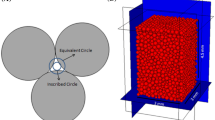Abstract
A proper understanding and eventual assessment of reservoir compaction and land subsidence is crucial for decision-making in petroleum and gas extraction industry. This paper presents a multi-scale multi-physics study of coupling mechanisms in the long-term compaction of oil/gas bearing sediments, also known as aging. The principal goal of this work is to quantify such coupling mechanisms at different scales and link phenomena occurring at micro- and meso-scales to a mathematical model formulated at a macroscopic continuum level. The interaction between mechanical and non-mechanical processes, originating from intergranular damage and dissolution was examined through modeling the involved phenomena at their respective micro- and meso-scales. Two major consequences that result from the intensified chemo-mechanical coupling were investigated: porosity reduction, and subsequent stiffness and permeability evolution. It appears that permeability is mildly affected by the contact area increase, and for most of the duration, by the precipitation of the mineral solute; stiffening of the grain system results from the mineral precipitation and the consequent redistribution of mass within the pore space.








Similar content being viewed by others

References
Cecconi M, DeSimone A, Tamagnini C, Viggiani GMB (2002) A constitutive model for granular materials with grain crushing and its application to a pyroclastic soil. Int J Numer Anal Methods 26:1531–1560
Denisov NY, Reltov BF (1961) The influence of certain processes on the strength of soils. Proc 5th Int Conf SMFE 1(12):75–78
Hu LB, Hueckel T (2007) Coupled chemo-mechanics of intergranular contact: toward a three-scale model. Comput Geotech 34(4):306–327
Hueckel T (2002) Reactive plasticity for clays during dehydration and rehydration. Part I: concepts and options. Int J Plast 18(3):281–312
Hueckel T, Hu LB (2009) Feedback mechanisms in chemo-mechanical multi-scale modeling of soil and sediment compaction. Comput Geotech 36(6):934–943
Hueckel T, Kaczmarek M, Caramuscio P (1997) Theoretical assessment off fabric and permeability changes in clays affected by organic contaminants. Can Geotech J 34(4):588–603
Hueckel T, Cassiani G, Fan T, Pellegrino A, Fioravante V (2001) Effect of aging on compressibility of oil/gas bearing sediments and their subsidence. J Geotech Geoenv Eng 127(11):926–938
Itasca (2008) PFC2D User’s Guide. Itasca Consulting Group Inc., Minneapolis, USA
Johnson KL (1985) Contact mechanics. Cambridge University Press, Cambridge
Kuhn M, Mitchell JK (1993) New perspectives on soil creep. J Geotech Eng 119(3):507–524
Kwok CY, Bolton MD (2010) DEM simulations of thermally activated creep in soils. Geotechnique 60(6):425–433
Le Guen Y, Renard F, Hellmann R, Brosse E, Collombet M, Tisserand D, Gratier J-P (2007) Enhanced deformation of limestone and sandstone in the presence of high PCO2 fluids. J Geophys Res 112:B05421
Mitchell JK, Solymar ZV (1984) Time-dependent strength gain in freshly deposited or densified sand. J Geotech Eng 110(11):1559–1576
Rimstidt JD, Barnes DL (1980) The kinetics of silica water reaction. Geochim Cosmoch Acta 44:1683–1699
Rutqvist J (2012) The geomechanics of CO2 storage in deep sedimentary formations. Geotech Geol Eng 30(3):525–551
Scott RF (1979) Subsidence—a review. In: Saxena SK (ed) Evaluation and prediction of subsidence. ASCE, New York, pp 1–25
Settari A, Walters DA (2001) Advances in coupled geomechanical and reservoir modeling with applications to reservoir compaction. SPE J 6(3):334–342
Tsoungui O, Vallet D, Charmet JC (1999) Numerical model of crushing of grains inside two-dimensional granular materials. Powder Technol 105:190–198
Wang YH, Xu D, Tsui KY (2008) Discrete element modeling of contact creep and aging in sand. J Geotech Geoenv Eng 134(9):1407–1411
Acknowledgments
This work was supported in part by US NSF grant CMMI-07-00294. The first two authors wish to gratefully acknowledge the financial support provided by the University of Toledo through a Faculty Summer Research Fellowship.
Author information
Authors and Affiliations
Corresponding author
Rights and permissions
About this article
Cite this article
Hu, L.B., Panthi, S. & Hueckel, T. Multi-scale Characterization of Coupling Mechanisms for Evolving Permeability in Oil/Gas Bearing Sediments Compaction. Geotech Geol Eng 31, 1671–1680 (2013). https://doi.org/10.1007/s10706-013-9658-y
Received:
Accepted:
Published:
Issue Date:
DOI: https://doi.org/10.1007/s10706-013-9658-y



